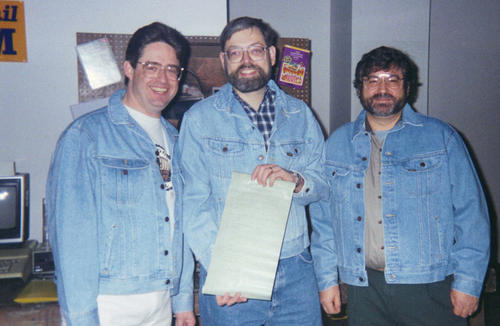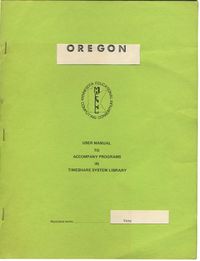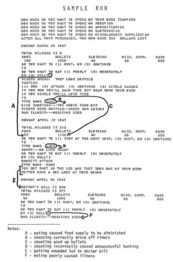Oregon (lost original version of "The Oregon Trail" educational computer game; 1971)
Bill Heinemann holding a printout of the 1971 source code and standing next to Don Rawitsch (left), and Paul Dillenberger (right).
Status: Lost
The Oregon Trail is a series consisting mainly of popular edutainment computer games. The basic premise of these games is to travel from Independence, Missouri, to Oregon with a wagon and limited resources. The games found major success among school students and in total, sold over 65 million copies worldwide.[1] While the most widely known version of The Oregon Trail is the 1985 version for the Apple II computer, it dates back all the way to 1971.
History
The Beginnings
"I can't really take credit for the initial spark of the idea for using computers, but it was my idea to try to incorporate some kind of game." - Don Rawitsch
Don Rawitsch, who was a student teacher working at Bryant Junior High School in Minneapolis, Minnesota, tried to find new ways to get his eighth grade history class interested in a new unit, called “The Western Expansion of the Mid-19th Century.”[2][3] While brainstorming with colleagues Bill Heinemann and Paul Dillenberger in 1971, Rawitsch revealed that he wanted to create a board game in which players traversed a map of trails taken by pioneers using "dice or cards."[4] Heinemann and Dillenberger, who were both math teachers and knowledgeable in programming, offered to turn it into a computer game that would later be named, Oregon.
A Computer Game
"This would be a perfect application for a computer." - Bill Heinemann
As part of his second teaching assignment, Rawitsch needed the game finished in two weeks. His colleagues spent that time coding it on an HP-2100 teletype device, or a "screen-less, electromechanical typewriter connected via telephone to a mainframe computer that could issue prompts, receive commands, and run primitive programs," housed in the school's "computer lab" or janitor's closet, while Rawitsch researched the probabilities of certain events that happened to settlers on their way to Oregon.[5][4][2]
First Impressions
"They would come in early to school, and they would stay late to play the game." - Paul Dillenberger
Before sending Oregon off to Rawitsch, Heinemann and Dillenberger tested the game with their own classes. Although reactions from students were quite positive, other teachers condemned it for including phrases that negatively depicted Native Americans. The two teachers later replaced all references of them with generic titles. Rawitsch finally presented the game to his history class on December 3rd, 1971 and let everyone have a chance of playing it in groups.[5] The game was also immensely popular with his class as they often "lined up outside the janitor’s closet after class to take turns".
Later Versions
When the semester was over, Rawitsch printed out Oregon's source code and deleted it from the school's mainframe. He later joined MECC in 1974 and spent his Thanksgiving weekend coding a revised version which was more historically accurate.[3] Like the original, this was made for the HP-2100, but it was also put into MECC's timeshare system.[6] In 1977, Oregon was ported to the CDC Cyber-73 system with even more changes. That version's source code was published in Volume 4 of Creative Computing Magazine for May-June the following year.[7]
Availability
None of the developers ever released the 1971 version of Oregon to the general public. After being inquired by Jimmy Maher, Rawitsch stated that he no longer had the original source code.[6] As of 2017, Heinemann stated that he has his copy but doesn't believe his son is "old enough to take stewardship" of it.[8]
Whilst the only official release that is remotely similar to it got published in 1978, Michael Gemeny found the 1975 MECC timeshare version on tape dated March 27th; it can be found here, while the 1977/1978 code can be found here. Bob Brown created an HP-2100 simulator for people to play these two versions without downloading an emulator.[6]
1. Telnet to mickey.publicvm.com.
2. Slowly alternate CTL-J and CTL-M until you see a “PLEASE LOG IN” message.
3. Enter “HEL-T001,HP2000,1”. Without the quotes — and note that those are zeroes.
4. Enter “EXE-OREGON” to load the 1975 version, “EXE-ORE2” to load the 1978 version.
Video
Gallery
References
- ↑ NPR interview with Paul Dillenberger. Retrieved 06 Apr '20
- ↑ 2.0 2.1 Overview of The Oregon Trail's origins. Retrieved 07 Apr '20
- ↑ 3.0 3.1 Mental Floss article on the history of The Oregon Trail. Retrieved 09 Apr '20
- ↑ 4.0 4.1 Yester interview with Don Rawitsch. Retrieved 07 Apr '20
- ↑ 5.0 5.1 Vice interview with The Oregon Trail's creators. Retrieved 07 Apr '20
- ↑ 6.0 6.1 6.2 Part 4 of The Digital Antiquarian's On the Trail of the Oregon Trail blog post. Retrieved 09 Apr '20
- ↑ Oregon Trail's section in Volume 4 of Creative Computing Magazine for May-June of 1978. Retrieved 09 Apr '20
- ↑ Business Insider article on The Oregon Trail's origins. Retrieved 09 Apr '20


